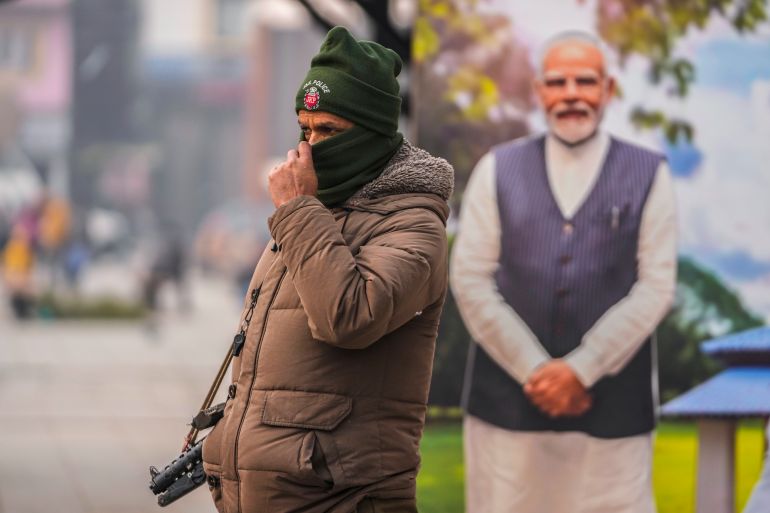What’s Article 370? What to know about India top court verdict on Kashmir
The Supreme Court backs Prime Minister Narendra Modi’s removal of Indian-administered Kashmir’s semi-autonomy.

In a major setback to Kashmiri political groups, India’s Supreme Court has upheld a 2019 decision by Prime Minister Narendra Modi’s government to revoke special status for Indian-administered Kashmir, which gave it a degree of autonomy.
The disputed Himalayan region is claimed in full although ruled in part by both India and Pakistan since their independence from Britain in 1947. The nuclear-armed neighbours have fought three of their four wars over it since then.
Keep reading
list of 4 itemsAt least 30 killed, dozens injured in Kashmir bus accident
Kashmiri journalist Fahad Shah walks out of jail after 600 days
Kashmir students accused of terror for ‘celebrating’ India World Cup loss
The court hearings began in August on a petition filed by Kashmiri individuals and groups.
The verdict is a big boost for the governing Hindu nationalist Bharatiya Janata Party (BJP) ahead of general elections due in May. The 2019 decision by the BJP was a campaign promise to end Article 370, which granted special status to the disputed Himalayan region.
Here is all you need to know about the issue:
What does Monday’s verdict say?
In its ruling, the Supreme Court said Jammu and Kashmir should be restored to the same statehood as any other Indian state – with no separate autonomy rights – “at the earliest and as soon as possible”.
The five-judge constitutional bench of the Supreme Court ruled the region’s special status had been a “temporary provision” and removing it in 2019 was constitutionally valid.
“Article 370 was an interim arrangement due to war conditions in the state,” Chief Justice DY Chandrachud said, referring to the provision in the Indian Constitution that provided the special status after Muslim-majority Kashmir’s Hindu ruler signed an agreement in 1947 to join India.
As part of the Instrument of Accession, India allowed Kashmir to retain its own constitution, flag and criminal code. Kashmir had its own prime minister and president until 1953 when New Delhi jailed its prime minister, Sheikh Abdullah, and abolished the post in what it said were efforts to integrate the Muslim-majority region with the rest of India.
Kashmir has been at the heart of more than 75 years of animosity between India and Pakistan.
Pakistan claims Kashmir as its own territory, saying the Muslim-majority area should have been part of the new state of Pakistan, created in 1947 when British colonial rule ended in the partition of the Indian subcontinent.
The First Kashmiri War broke out soon after partition and ended in 1949 with a United Nations-mediated ceasefire that divided Kashmir into Pakistani- and Indian-administered regions.
What is Article 370?
Article 370, which came into effect in October 1949, granted Kashmir autonomy of internal administration, allowing it to make its own laws in all matters except finance, defence, foreign affairs and communications.
The Indian-administered region established a separate constitution and a separate flag and denied property rights in the region to outsiders.
Article 35A, a further provision added to Article 370 in 1954, empowered state lawmakers to ensure special rights and privileges for permanent residents of the state.
With the repeal of Article 370, Article 35A was also scrapped, allowing non-Kashmiris to buy property in the region and raising fears that India is trying to engineer a “demographic shift” in the Muslim-majority region.
In 2019, Modi’s government also bifurcated Kashmir into two regions – Jammu and Kashmir in the west and Ladakh in the east – to be ruled directly from New Delhi. Kashmir lost its flag, criminal code and constitution enshrined in Article 370.
No regional elections have been conducted in the two regions since then, but the Supreme Court ordered Indian-administered Kashmir to hold local legislative elections by September 30 next year.
What are the reactions to this verdict?
Modi called the judgement “a beacon of hope, a promise of a brighter future and a testament to our collective resolve to build a stronger, more united India”.
“The court, in its profound wisdom, has fortified the very essence of unity that we, as Indians, hold dear and cherish above all else,” he said in a post on X.
Challengers of his government’s 2019 decision maintained that only the Constituent Assembly of Indian-administered Kashmir could decide on the special status of the region and contested whether the Indian Parliament had the power to revoke it.
“Disappointed but not disheartened,” Omar Abdullah, a former chief minister and vice president of the Jammu & Kashmir National Conference party, posted on X. “The struggle will continue. It took the BJP decades to reach here. We are also prepared for the long haul.”
Disappointed but not disheartened. The struggle will continue. It took the BJP decades to reach here. We are also prepared for the long haul. #WeShallOvercome #Article370
— Omar Abdullah (@OmarAbdullah) December 11, 2023
Mehbooba Mufti, another former chief minister and president of the Jammu and Kashmir People’s Democratic Party, echoed those views. “The people of J&K are not going to lose hope or give up. Our fight for honour and dignity will continue regardless. This isn’t the end of the road for us,” she posted on X.
The people of J&K are not going to lose hope or give up. Our fight for honour and dignity will continue regardless. This isn’t the end of the road for us. pic.twitter.com/liRgzK7AT7
— Mehbooba Mufti (@MehboobaMufti) December 11, 2023
Many Kashmiris view the 2019 decision as an annexation, saying new laws were designed to change the region’s demographics. Members of minority Buddhist communities initially welcomed the move, but many of them later expressed fear of losing land and jobs in the Himalayan area.